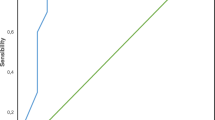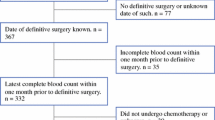Abstract
Purpose
Preoperative neutrophil count is reportedly associated with poor prognosis in cancer patients. This study aimed to investigate the clinical significance of pre-treatment peripheral blood cell counts in patients with thymic epithelial tumors (TETs).
Methods
A retrospective review of 71 patients with completely resected TETs [64 thymoma, 6 thymic carcinoma, and 1 thymic neuroendocrine tumor] between 2000 and 2018 was conducted. Associations between tumor recurrence and pre-treatment peripheral blood cell counts of leukocytes (WBC), neutrophils (Neut), lymphocytes (Lymph), monocytes (Mono), and platelets (Plt) were analyzed. Optimal cut-off points were selected using receiver operating characteristic curve analysis to predict tumor recurrence.
Results
High WBC (≥ 7000), Neut (≥ 4450), and Plt (≥ 226 × 103) counts had significantly poor relapse-free survival (RFS), but high Lymph (≥ 1950) and Mono (≥ 400) did not. High Neut had the strongest correlation with recurrence (area under curve, 0.800); we focused on the analysis between high-Neut and low-Neut groups. High Neut count significantly correlated with smoking history, pre-treatment C-reactive protein level, and advanced stage; high Neut count and aggressive histology tended to show correlations. RFS was significantly poorer in the high-Neut group than in the low-Neut group (p = 0.003), with 5-year RFS rates of 63.8% and 96.8%, respectively. High Neut count was a significant adverse predictor for RFS and cumulative incidence of recurrence (p = 0.005 and p < 0.001, respectively). The risk scoring system comprising high Neut count, advanced stage, and aggressive histology demonstrated better prognostic ability than any prognostic factors alone.
Conclusions
High Neut count significantly correlated with TET recurrence, suggesting a negative prognostic effect of latent inflammation in TET patients.




Similar content being viewed by others
References
de Jong WK, Blaauwgeers JL, Schaapveld M, Timens W, Klinkenberg TJ, Groen HJ. Thymic epithelial tumors: a population-based study of the incidence, diagnostic procedures and therapy. Eur J Cancer. 2008; 44:123–30.
Marx A, Chan JK, Coindre JM, et al. The 2015 World Health Organization classification of tumors of the thymus: continuity and changes. J Thorac Oncol. 2015; 10:1383–95.
Detterbeck FC, Stratton K, Giroux D, et al. The IASLC/ITMIG thymic epithelial tumors staging project: proposal for an evidence-based stage classification system for the forthcoming (8th) edition of the TNM classification of malignant tumors. J Thorac Oncol. 2014; 9:S65–72.
Fukui T, Fukumoto K, Okasaka T, et al. Clinical evaluation of a new tumor-node-metastasis staging system for thymic malignancies proposed by the International Association for the Study of Lung Cancer Staging and Prognostic Factors Committee and the International Thymic Malignancy Interest Group. Eur J Cardiothorac Surg. 2016; 49:574–9.
Okumura M, Yoshino I, Yano M, et al. Tumor size determines both recurrence-free survival and disease-specific survival after surgical treatment for thymoma. Eur J Cardiothorac Surg. 2019; 56:174–81.
Detterbeck F, Youssef S, Ruffini E, Okumura M. A review of prognostic factors in thymic malignancies. J Thorac Oncol. 2011; 6:S1698–S1704.
Takahashi Y, Horio H, Hato T, et al. Prognostic significance of preoperative neutrophil-lymphocyte ratios in patients with stage I non-small cell lung cancer after complete resection. Ann Surg Oncol. 2015; 22:S1324–31.
Templeton AJ, McNamara MG, Seruga B, et al. Prognostic role of neutrophil-to-lymphocyte ratio in solid tumors: a systematic review and meta-analysis. J Natl Cancer Inst. 2014; 106:dju124.
Sionov RV, Fridlender ZG, Granot Z. The multifaceted roles neutrophils play in the tumor microenvironment. Cancer Microenviron. 2015; 8:125–58.
Ocana A, Nieto-Jimenez C, Pandiella A, Templeton AJ. Neutrophils in cancer: prognostic role and therapeutic strategies. Mol Cancer. 2017; 16:137.
Nakajima J, Murakawa T, Fukami T, Sano A, Takamoto S, Ohtsu H. Postthymectomy myasthenia gravis: relationship with thymoma and antiacetylcholine receptor antibody. Ann Thorac Surg. 2008;86:941–45.
Yamada Y, Yoshida S, Iwata T, et al. Risk factors for developing postthymectomy myasthenia gravis in thymoma patients. Ann Thorac Surg. 2015; 99:1013–19.
Moran CA, Weissferdt A, Kalhor N, et al. Thymomas I: a clinicopathologic correlation of 250 cases with emphasis on the World Health Organization schema. Am J Clin Pathol. 2012; 137:444–50.
Strobel P, Bauer A, Puppe B, et al. Tumor recurrence and survival in patients treated for thymomas and thymic squamous cell carcinomas: a retrospective analysis. J Clin Oncol. 2004; 22:1501–09.
Yanagiya M, Nitadori JI, Nagayama K, Anraku M, Sato M, Nakajima J. Prognostic significance of the preoperative neutrophil-to-lymphocyte ratio for complete resection of thymoma. Surg Today. 2018; 48:422–30.
Janik S, Raunegger T, Hacker P, et al. Prognostic and diagnostic impact of fibrinogen, neutrophil-to-lymphocyte ratio, and platelet-to-lymphocyte ratio on thymic epithelial tumors outcome. Oncotarget. 2018; 9:21861–75.
Janik S, Bekos C, Hacker P, et al. Elevated CRP levels predict poor outcome and tumor recurrence in patients with thymic epithelial tumors: a pro- and retrospective analysis. Oncotarget. 2017; 8:47090–102.
Yuan ZY, Gao SG, Mu JW, et al. Prognostic value of preoperative neutrophil-lymphocyte ratio is superior to platelet-lymphocyte ratio for survival in patients who underwent complete resection of thymic carcinoma. J Thorac Dis. 2016; 8:1487–96.
Muriana P, Carretta A, Ciriaco P, Bandiera A, Negri G. Assessment of the prognostic role of neutrophil-to-lymphocyte ratio following complete resection of thymoma. J Cardiothorac Surg. 2018; 13:119.
Meager A, Wadhwa M, Dilger P, et al. Anti-cytokine autoantibodies in autoimmunity: preponderance of neutralizing autoantibodies against interferon-alpha, interferon-omega and interleukin-12 in patients with thymoma and/or myasthenia gravis. Clin Exp Immunol. 2003; 132:128–36.
Rosales C. Neutrophil: a cell with many roles in inflammation or several cell types? Front Physiol. 2018; 9:113.
Granot Z, Henke E, Comen EA, et al. Tumor entrained neutrophils inhibit seeding in the premetastatic lung. Cancer Cell. 2011; 20:300–14.
Inai K, Takagi K, Takimoto N, et al. Multiple inflammatory cytokine-productive ThyL-6 cell line established from a patient with thymic carcinoma. Cancer Sci. 2008; 99:1778–84.
Teramukai S, Kitano T, Kishida Y, et al. Pretreatment neutrophil count as an independent prognostic factor in advanced non-small-cell lung cancer: an analysis of Japan Multinational Trial Organisation LC00-03. Eur J Cancer. 2009; 45:1950–58.
Marulli G, Margaritora S, Lucchi M, et al. Surgical treatment of recurrent thymoma: is it worthwhile? Eur J Cardiothorac Surg. 2016; 49:327–32.
Acknowledgement
This work was supported by Grant-in-Aid for Scientific Research, Japan Society for the Promotion of Science (JSPS KAKENHI Grant No. J16K10705).
Author information
Authors and Affiliations
Corresponding author
Ethics declarations
Disclosures
Satoru Okada, Masanori Shimomura, Hiroaki Tsunezuka, Shunta Ishihara, Satoshi Ikebe, Tatsuo Furuya, Junichi Shimada, Satoshi Teramukai, and Masayoshi Inoue declare there are no conflicts of interest to disclose.
Additional information
Publisher's Note
Springer Nature remains neutral with regard to jurisdictional claims in published maps and institutional affiliations.
Electronic supplementary material
Below is the link to the electronic supplementary material.
Rights and permissions
About this article
Cite this article
Okada, S., Shimomura, M., Tsunezuka, H. et al. High Neutrophil Count as a Negative Prognostic Factor for Relapse in Patients with Thymic Epithelial Tumor. Ann Surg Oncol 27, 2438–2447 (2020). https://doi.org/10.1245/s10434-020-08228-9
Received:
Published:
Issue Date:
DOI: https://doi.org/10.1245/s10434-020-08228-9




